
‘Godard’s work poses fundamental questions about narrative. While his first films, such as Breathless and A Woman Is a Woman, have fairly straightforward plots, he gradually moved toward a more fragmentary, collage structure. A story is still apparent, but it is deflected into unpredictable paths. Godard juxtaposes staged scenes with documentary material (advertisements, comic strips, crowds passing in the street), often with little connection to the narrative. Far more than his New Wave contemporaries, Godard mixes conventions drawn from popular culture, such as detective novels or Hollywood movies, with references to philosophy or avant-garde art. The inconsistencies, digressions, and disunities of Godard’s work make most New Wave films seem quite traditional by comparison.’ – Kristin Thompson & David Bordwell
‘Godard is the first filmmaker to bristle with the effort of digesting all previous cinema and to make cinema itself his subject. He emerged from the darkness of the Cinémathèque rather than from any plausible biographical background… Filmmaking for Godard is neither occupation nor vocation, it is existence itself. His inescapable dialectic is in terms of cinema and his politics have arisen – disastrously, I think – from cinema theory.’ – David Thomson
‘Whether he delights or irritates you, Godard sits securely in the front rank of screen originals, and it is good that he succeeded in rejoining the mainstream of French cinema in 1980 after more than ten years’ self-exile to its fringes… Nonetheless the quality of his films has been much more variable in recent times compared to his heyday of the 1960s, including a disastrous modernised sideshoot of King Lear.’ – David Quinlan
‘If influence on the development of world cinema is the criterion, then Jean-Luc Godard is certainly the most important filmmaker of the past thirty years; he is also one of the most problematic… As ex-Cahiers du Cinema critic and New Wave filmmaker, Godard was initially linked with Truffaut and Chabrol in a kind of revolutionary triumvirate; it is easy, in retrospect, to see that Godard was from the start the truly radical figure, the “revolution” of his colleagues operating purely on the aesthetic level and easily assimilable to the mainstream.” – Robin Wood and Rob Edelman (The St. James Film Directors Encyclopedia, 1998)
‘Godard’s impact on the cinema of the 60s was cataclysmal and sweeping and his contribution to the art, thought, and language of the cinema significant. He used the camera not only creatively and inventively, rewriting the syntax of film grammar along the way, but also as a means of personal expression to tell the “the truth 24 times a second”… In removing himself from the mainstream and subjugating his role as an artist to a mission as a political activist, Godard knowingly relinquished his following, along with it his once-considerable influence on the shaping of cinema as a thinking man’s art.’ – The MacMillan International Film Encyclopedia, 1994
‘Godard’s critical engagement with form is another constant in his oeuvre, which has remained more radical and experimental than that of any of his nouvelle vague peers. That crucial disjunction between picture and sound (he and partner Anne-Marie Miéville formed a production company called “Sonimage” in the 1970s) i s every bit as central to his films as his politics (which famously swung towards Maoism in the late 1960s), or such recurring themes as prostitution and imperialism.’ – Tom Charity (The Rough Guide to Film, 2007)
‘Godard is one of the most important filmmakers in cinema history. He has made audiences think about how films are made in a series of dramatic essays on subjects ranging from the Hollywood gangster film to the musical, the Marxist struggle, and films, filming, and filmmakers themselves.” – William R. Meyer
‘For me, discovering cinema was directly connected to his films. I was living in Paris at the time. When Made in USA opened, I went to the first show – it was around noon – and I sat there until midnight. I saw it six times in a row.’ – Wim Wenders
‘The cinema is not an art which films life: the cinema is something between art and life. Unlike painting and literature, the cinema both gives to life and takes from it, and I try to render this concept in my films. Literature and painting both exist as art from the very start; the cinema doesn’t.’ – Jean-Luc Godard
‘To me style is just the outside of content, and content the inside of style, like the outside and the inside of the human body. Both go together, they can’t be separated.’ – Jean-Luc Godard
‘There is cinema before Godard and after Godard.’ – François Truffaut
___
Stills
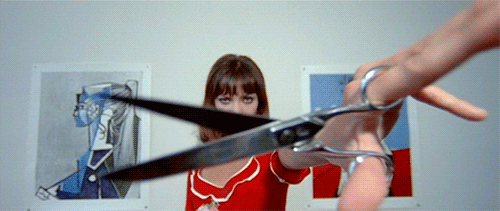


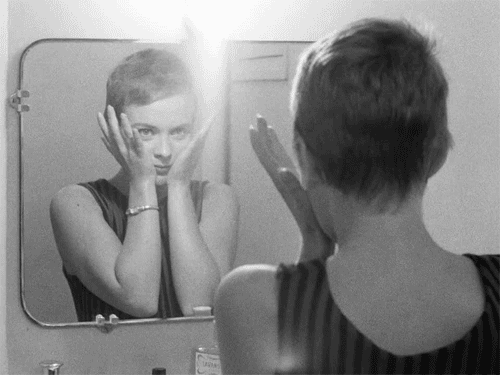













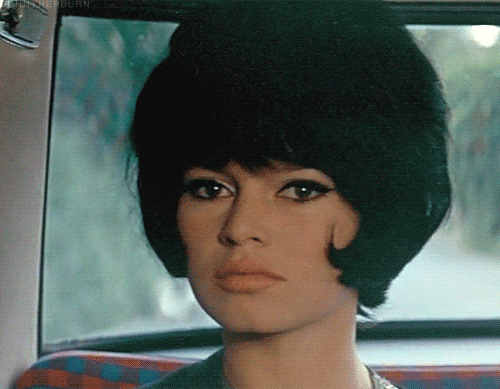

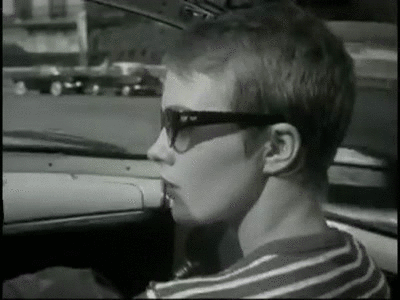












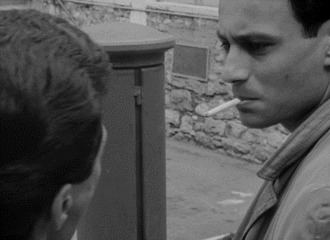


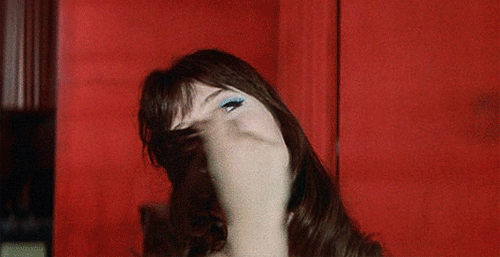





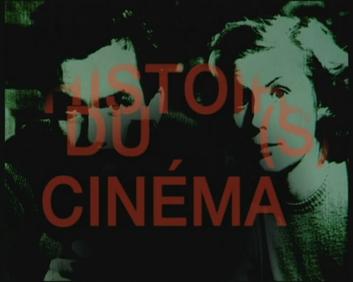


























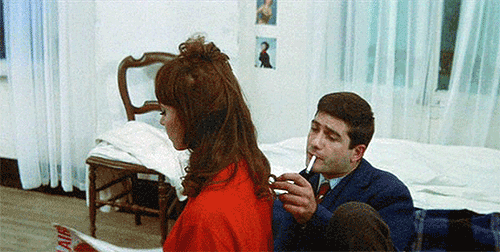
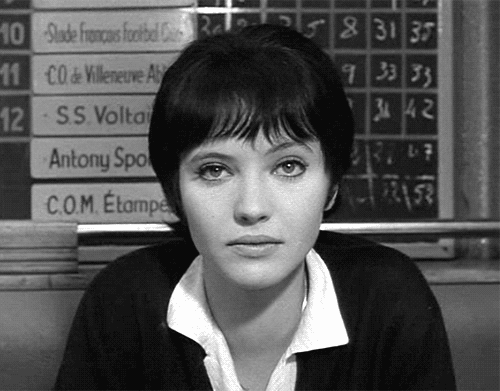

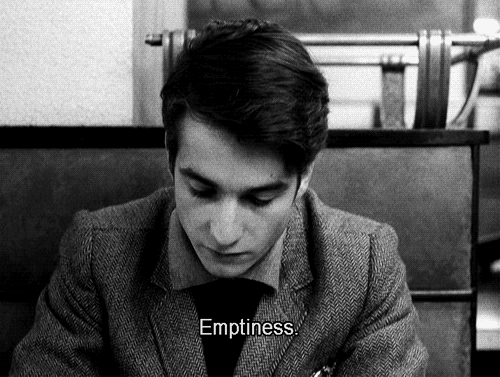
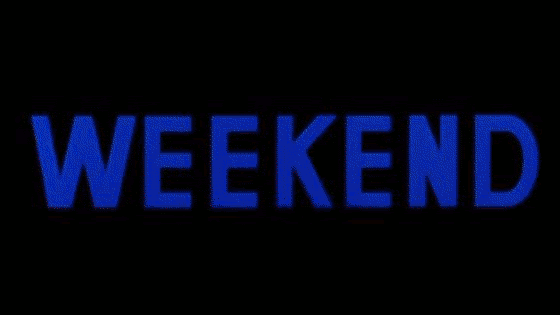
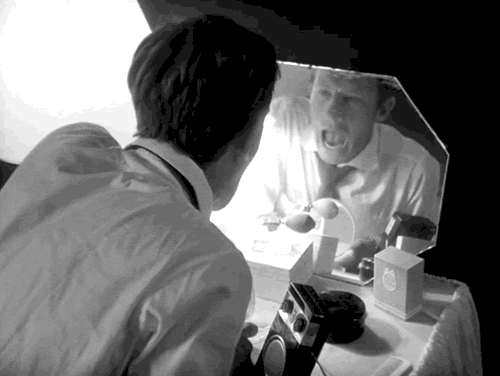





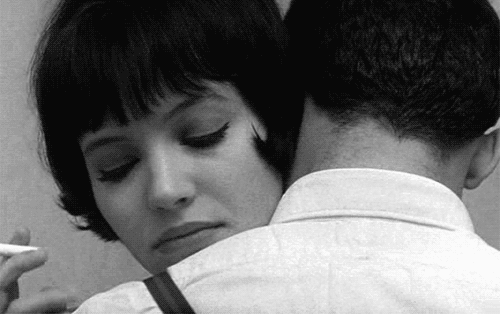

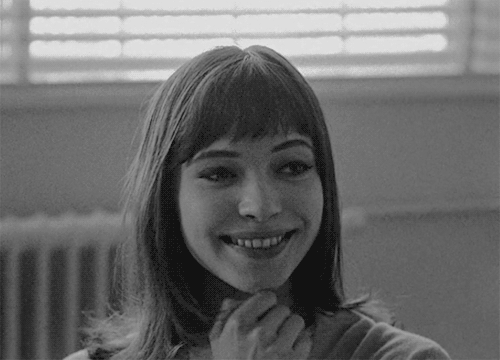
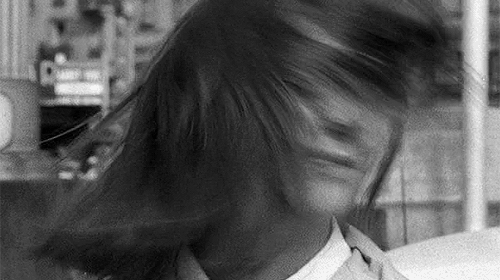
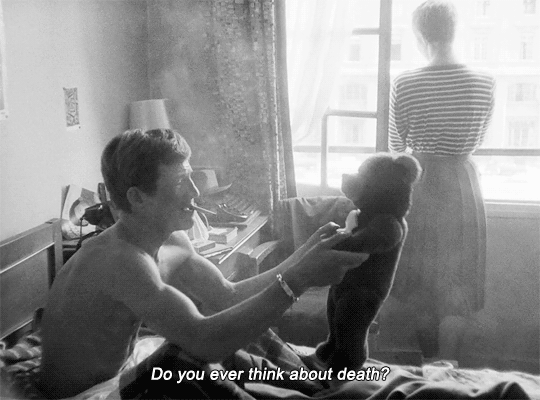

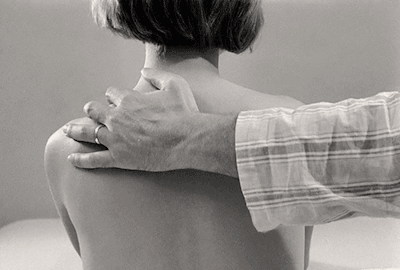
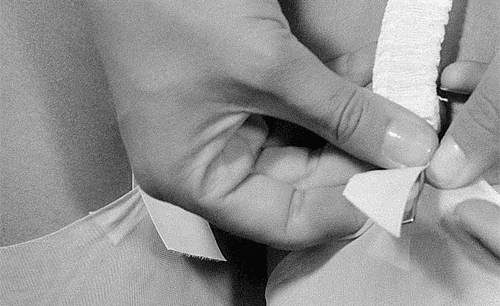
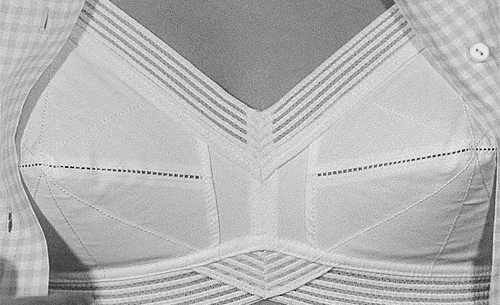

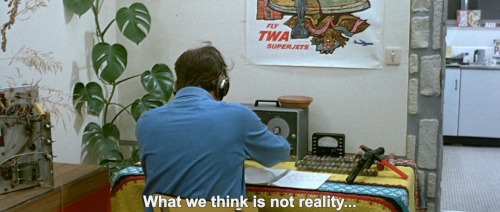



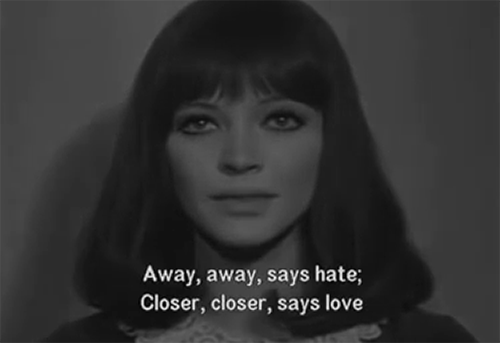
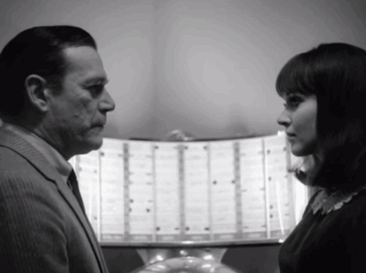




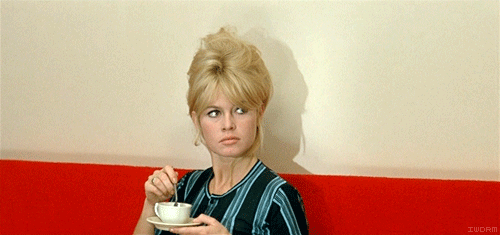


_____
Further
Jean-Luc Godard @ IMDb
Cinema=Godard=Cinema
J-LG @ The Criterion Collection
J-LG @ MUBI
Where to begin with Jean-Luc Godard – the early stuff
Jean-Luc Godard Laments Advent of Streaming, Compares it to the End of Silent Film
Jean-Luc Godard pourrait s’inspirer des gilets jaunes pour un prochain film
Jean-Luc Godard: a beginner’s guide
J-LG @ Editions POL
Claude Lelouch tacle Jean-Luc Godard : “Il ne faut pas être chiant quand on fait un film”
Cher Jean-Luc,
J-LG @ New Wave Film
Jean-Luc Godard’s Political Filmmaking
Jean-Luc Godard, l’insurgé
10 FILMS QUI ONT INFLUENCÉ LE CINÉMA DE JEAN-LUC GODARD
____
Extras
How Jean-Luc Godard Liberated Cinema
Jean-Luc Godard – Nouvelle vague (1990)
Jean-Luc Godard – 28 minutes – ARTE
Jean-Luc Godard receives the 2019 FIAF Award at the Cinémathèque suisse
_____
Interview (1969)
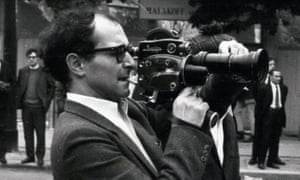
When you were in Berkeley and met some of the students, you made a statement that a film is a practical rifle and a rifle is a practical film.
Well, I gave another definition in an interview I had with a French newspaper: the film is a scientific experiment. I will give you a theoretical example. You need a film just as guerrillas — —trekking about in the night, good users of rifles –— need a light, a small light, in order to see. But it’s not exactly a gun. It’s a light which helps you check with your gun. But I still think it’s a theoretical gun and I’ll keep to this definition.
Why is it that in the last few films, your portrayal of the hippie revolutionaries, in Weekend let’s say, and in One Plus One, those two boys in the pornography bookshop….
They were not hippies. Their long hair isn’t necessarily related to hippieness. It could be to clergymen, too. No, they were not hippies. They were just oppressed people.
Well, let’s stick to Weekend then, where you have the band of hippie guerrillas.
Yes, but that was two years ago and it was the French situation of that time. It was different. It was utopian. And even then, they were more Yippies than hippies because they didn’t hesitate to take up guns. Yippies in a French way, maybe. I remember a discussion in Berkeley this year. I had an interview with Eldridge Cleaver and he was reproaching people like Jerry Rubin and Abbie Hoffman. He said, “Those Yippie people like toy guns. We Black Power people like real guns.”
One of the problems I felt about the Yippies you portrayed in Weekend was that I was never sure whether there was any causal relationship between their will and the situation they were involved in, whether they were really a reflection of what was happening, whether they were in fact controlling the situation in some way, or whether they were just victims.
They were terrorists. Or nihilists. Like the first young Russian nihilists putting bombs under the Tzar. They were nihilists and not really revolutionary, but revolutionaries are sometimes nihilists too.
Isn’t there a similarity between the two characters in Weekend who wander off on their trip to the mother’s home and the two characters in Pierrot le Fou. They have that picaresque quality to them. They travel around and things happen to them.
Maybe, because this movie was done with personal feeling and intuition. After the May-June events I became aware of how late I was. Weekend wasn’t done with a script. It came from a personal feeling, a personal intuition, as in Pierrot le Fou. But the intuition in Weekend was closer to the social situation in France than it was in Pierrot le Fou. It came from a clear political analysis and was then transformed into a movie.
One Plus One was more of that, and the next one, the American film, will be more yet. The idea is to make the script out of a political analysis and then to convey that, sometimes in poetry, sometimes science, sometimes all it takes is a film. The film itself is less and less spectacular because I think very strongly now that the more spectacular you are, the more you are absorbed by the things you are trying to destroy. You don’t destroy anything at all, and it’s you who are destroyed because of the spectacle. Some real examples are the films done in Hollywood about Che Guevara and Malcolm X. If Metro-Goldwyn-Mayer is going to do a movie about Che Guevara, the Cubans should be making it, but if Fidel Castro writes the script, Metro-Goldyn-Mayer won’t distribute it. So you can’t do it.
After Pierrot le Fou, your films changed.
Let’s say that early period was my hippie period. I was addicted to movies as the hippies are addicted to marijuana. Now I went through marijuana (I don’t smoke marijuana, but I don’t need to because movies are the same to me), but now I’m over this movie marijuana magic thing.
All the earlier films were extremely romantic – the sensibilities of all your protagonists were related: all of them seemed to be dominated by the feeling of early death, lack of relationships and detachment. All those early characters died, except for the character in Le Petit Soldat, and he was a fascist character.
Yes, but I’m realizing that only today. Yes, because I was an idealist, and the idea of death relating to love and things like that is not completely fascist maybe, but if you get too much involved in that, you are going in the wrong direction. It’s a bourgeois philosophy, and it’s an ideology I was guilty of.
Wasn’t it hard for you to give it up?
No, because it was just one step after another.
Don Siegel’s films are usually very right wing. The idea of an action film, which you were obviously influenced by in your early films, usually leads to a kind of right wing philosophy, where-as now you’ve gotten rid of the action and…
I quite agree with you. The film that made Potemkin possible was a fascist American movie called Intolerance. But they took out of it just what they needed, from a very technical standpoint, and then they changed it.
You’ve gotten rid of the action sequences now in One Plus One.
That may be, for the moment. I don’t know what action is. I’m trying to demystify the movies at the same time as making them. I’m always amazed that so many of the militants are so fond of westerns, which I hate. They are not bothered by the fact that it’s a fascist form. They don’t care. They enjoy it. But a lot of people who lack their intelligence or their militancy are poisoned by that. The militants aren’t, but the other people, the so-called ordinary people are.
That’s why the scientists of the movie or of the theatre or of literature have to work on theory, to try to indicate how to found new bases, a new grammar, a new philosophy, a new mathematics out of it. And you discover how to do that by being linked to the militant people, by being yourself as militant as you can. It’s very well explained in a Mao quotation. He said: Where are the right ideas coming from? Are they coming from the sky? No. They are coming from social practice. What is social practice? There are three kinds. There is scientific experiment. There is struggle for production and there is the class struggle.
And I’ve discovered, at about the same time as the major events occurred in France, that I was working only in the field of scientific experiment, and I myself have to be related to class struggle and struggle for production, though scientific experiment is still necessary.
This means of course that people who loved your films such as Bande a Part are going to be disappointed now, aren’t they?
Yes. But movies like Bande a Part could still be done, but in a happier society, later, when we’ve found the right way to do it. Instead of being apart from the society, one will be in it. The fantasy at the end of Bande a Part will become real.
Do you think that’s really possible?
Yes. We will do it. To make the end of Bande a Part possible, we have to have a South American revolution. After they’ve done that, and if we could help them to do it, the situation in South America will be much better.
It’s all or nothing with you now, isn’t it?
I prefer all. It’s because I take it that all is possible, we don’t have to give it away for nothing. Or pretend that since all is impossible, we might as well prefer nothing for the moment, the way hippies and others think.
Towards the end of Weekend, you use a slogan to the effect that one can only surpass the horror of the bourgeoisie with more horror.
Yes, I think so. Especially in the scientific experimentation. Not in the struggle for production or power, but in scientific experimentation, yes. You have to burn the opera. Not British Motor Corporation or General Motors, because that’s not so clear. You do have to build some cars. But Covent Garden, Lincoln Center, the San Francisco Opera House, yes, we can burn them.
But there are still beautiful operas around.
We’ve tried other ways, but it’s no use. If we don’t burn them we’ll always be absorbed by going into them.
It’s strange that you would be willing to burn Schoenberg’s Moses and Aaron and not General Motors.
No, not burn them, just forget about them a bit. As Mao said, if we burn books, we would not know how to criticize them.
In Pierrot le Fou Belmondo says, speaking for you I suppose, that what he’s interested in are the colors and the spaces between people. And now apparently you’ve said that what is alive is not what is on the screen but what is between the spectator and the screen. What do you mean by that?
I mean that the movie is not on screen. The movie stems from moving. The movie is a mover. The move from the reality to the screen and back to the reality. And the screens are nothing, just shades. It’s like a swimmer doing a crawl until he arrives at the end of the swimming pool and then turning and going back again. This is the screen.
Who is the swimmer, filmmaker or spectator?
They both are. When you arrive, it’s the moviemaker; and when you start, it’s the spectator.
_______________
41 of Jean-Luc Godard’s 127 films
_______________
Operation Concrete (1958)
‘Opération béton is a documentary made by French filmmaker Jean-Luc Godard, preceding his work in narrative, fiction film. After returning to Switzerland, Godard went to work as an ouvrier at a dam building site, using the money he earned to buy a camera, and il a fait a short documentary about the building of the dam.’ — collaged
the entirety
______________
Breathless (1960)
‘Between 1958 and 1963 an astonishing 170 French filmmakers directed their first features, happily marching under the new wave banner, which was as vague as it was in vogue. But few were truly radical and innovative. The chief exception was Godard, the 30-year-old Franco-Swiss intellectual, as passionate about Hegel as he was about Hitchcock, an artist bent on transforming the nature of cinema and with it the world. “Godard is not merely an iconoclast,” that prophet of modernism Susan Sontag declared in 1968, “he is a deliberate ‘destroyer’ of cinema.” Breathless was the real thing. It was what we’d been waiting for, and it has taken its place alongside 20th-century works that have become familiar landmarks yet not lost their ability to shock and surprise: Stravinsky’s The Rite of Spring, Eliot’s The Waste Land, Joyce’s Ulysses, Dali and Buñuel’s Un Chien andalou, Picasso’s Guernica, Welles’s Citizen Kane, Beckett’s Waiting for Godot, Burroughs’s Naked Lunch. They are what Ezra Pound was talking about when he said that “great literature is news that remains news”.’ — Philip French
Excerpt
_______________
Le Petit Soldat (1963)
‘Godard’s second feature (which he called his “first real film”) was banned in France for three years due to its depiction of torture and terrorism in the Algerian War, and its political concerns continue to seem almost terrifyingly topical. A clenched portrait of a self-absorbed news photographer (Michel Subor) who moonlights as a political assassin for the right-wing terrorist organization OAS, Le Petit Soldat marks two milestones in Godard’s cinema: not only does it contain the immortal line about cinema being “truth 24 times a second,” but it also inaugurates the director’s Anna Karina period, with the actress here playing a model and perhaps revolutionary with whom Subor’s “little soldier” falls in love. Claire Denis, the subject of a TIFF Cinematheque retrospective last season, was so influenced by the film that she cast Subor in her own Beau travail as a character who goes by the actor’s Soldat sobriquet Bruno Forestier.’ — TIFF
Trailer
Jean Luc Godard parle de son film “Le Petit soldat”
_______________
Charlotte et son jules (1961)
‘A Godard short inspired by Jean Cocteau’s Le Bel Indifferent, a one-act play he wrote for Edith Piaf , Charlotte et son Jules changes the gender of the original roles: instead of a female nightclub singer, we get Belmondo berating his lover for her unfaithful ways. Inverting the genders could have turned the whole piece into the misogynist musings of a scorned lover, but thankfully Godard uses this to poke fun at Belmondo’s macho persona, rambling on and on for nearly 10 minutes without letting Charlotte speak. In Cocteau’s piece the cheating lover refuses to engage with his girlfriend, completely ignoring her pleas while he skims the newspaper, but here Charlotte remains disengaged because Belmondo won’t let her get a word in.’ — Kristhian Morales
the entirety
_______________
A Woman Is a Woman (1961)
‘Recently upon re-watching A Woman is a Woman I was reminded of how Jean-Luc Godard’s visual narrative is the succulent treat that drew me to this film like a candy store to a sugar deprived child. Watching A Woman is a Woman is just visually tantalizing. Notably shot in CinemaScope, the images burst into bold, striking colors on the screen which is a testament to the film’s meticulous cinematography as well as its precise placement and arrangement of primary colors throughout each scene. Blues and reds are in constant battle with one another being separated on numerous occasions with eggshell white. If walls are blue, towels will be yellow, if Angéla wears crimson stockings, her dress will be ivory or navy. The bright assault of colors makes the screen hard to look away from.’ — The Cinephiliac
Excerpt
________________
Vivre Sa Vie (1962)
‘Vivre sa vie was a turning point for Jean-Luc Godard and remains one of his most dynamic films, combining brilliant visual design with a tragic character study. The lovely Anna Karina, Godard’s greatest muse, plays Nana, a young Parisian who aspires to be an actress but instead ends up a prostitute, her downward spiral depicted in a series of discrete tableaux of daydreams and dances. Featuring some of Karina and Godard’s most iconic moments—from her movie theater vigil with The Passion of Joan of Arc to her seductive pool-hall strut—Vivre sa vie is a landmark of the French New Wave that still surprises at every turn.’ — The Criterion Collection
Excerpt
________________
Les Carabiniers (1963)
‘Jean-Luc Godard’s 1963 film Les Carabiniers is a carnivalesque procession of sight gags and consumerist satire—a skewering of the French government’s manipulation of its citizenry that set an early precedent for Godard’s full-on turn to political filmmaking in the late ‘60s. Unlike Contempt, which is also from the same year but beholden to a straightforward narrative, nothing that occurs throughout Les Carabiniers can be taken at face value. This account of two poor and ignorant brothers lured off to war by the promise of riches and urbanity is far from realistic, as Godard structures the film as a series of comic sketches rather than a fully developed dramatic piece.’ — Slant Magazine
Excerpts
_____________
Contempt (1963)
‘Proclaimed “the greatest work of art produced in postwar Europe” by Godard authority and biographer Colin MacCabe, Contempt is the first of many Godard films about the making of a film, both a vicious obituary for Hollywood cinema and a melancholy portrait of the end of a marriage. Michel Piccoli plays a scriptwriter hired by vulgar, stentorian American producer Jack Palance to turn Homer’s Odyssey into a sexy costume spectacle to be directed by Fritz Lang (playing himself, brilliantly and movingly). Piccoli’s bored wife Brigitte Bardot, feeling abandoned and prostituted by her husband, drifts into a wary affair with Palance; their flight to Rome, the Eternal City, ends in tragedy. Among Contempt’s many inexhaustible splendours is Godard’s use of colour: a Mondrian boogie-woogie of bold reds and blues across the blanched field of an unfinished apartment is central to the film’s formal design. “One of the masterworks of modern cinema” (Phillip Lopate, The New York Times).’ — TIFF
Trailer
Excerpt
_______________
Band of Outsiders (1964)
‘Four years after Breathless, Jean-Luc Godard reimagined the gangster film even more radically with Band of Outsiders (Bande à part). In it, two restless young men (Sami Frey and Claude Brasseur) enlist the object of both of their fancies (Anna Karina) to help them commit a robbery—in her own home. This audacious and wildly entertaining French New Wave gem is at once sentimental and insouciant, effervescently romantic and melancholy, and it features some of Godard’s most memorable set pieces, including the headlong race through the Louvre and the unshakably cool Madison dance sequence.’ — The Criterion Collection
Trailer
Behind the scenes
_____________
Une Femme Mariée (1964)
‘A witty, sensual, and controversial update of Madame Bovary for the age of Roland Barthes and Hugh Hefner, Une femme mariée was condemned by the Catholic Church and was heavily censored in France, where authorities also insisted that the film’s title be changed — from The Married Woman to A Married Woman — so as not to impugn French womanhood. The eponymous femme (Macha Méril) shuttles between her husband and her lover, enjoying the attentions of both but attempting to ignore their demands that she develop her sexual “assets” according to the incessant dictates of billboards, television, and such magazine articles as “How to Strip for Your Husband.” Warming up for Two or Three Things I Know About Her, Godard posits marriage as legalized prostitution, and explores the (de)formation of the self by advertising and the commodification of sex by consumer capitalism.’ — TIFF
Trailer
________________
Alphaville (1965)
‘Expatriate American actor Eddie Constantine plays Lemmy Caution, a trenchcoat-wearing secret agent. Constantine had already played this or similar roles in dozens of previous films; the character was originally created by British pulp novelist Peter Cheyney. However, in Alphaville, director Jean-Luc Godard moves Caution away from his usual twentieth century setting, and places him in a futuristic sci-fi dystopia, the technocratic dictatorship of Alphaville.’ — remysoubanere.com
Excerpt
_______________
Pierrot le Fou (1965)
‘By the mid-1960s, Jean-Luc Godard was at a crossroads. In a mere five years he had made nine feature films, which, through their audacious brilliance, had made him the most talked about director in the world. By and large, these earlier films had relied on pre-existing frameworks or genres as a basis out of which their creator’s extraordinary knack for spontaneous invention could flourish. But by the time he started shooting Pierrot le fou, the film noir conventions underlying its source novel, Lionel White’s Obsession, on longer interested him. Instead, the rapidly escalating war in Vietnam, the break up of his marriage to Anna Karina, and his own self-doubt concerning the value of what he had achieved, spurred Godard on to new heights of creative originality. He said that, in making Pierrot le fou, he felt as if he were making his ‘first film’; tearing up the old road map and setting out for unknown territory.’ — New Wave Film
Trailer
Jean-Luc Godard raconte “Pierrot Le Fou”
_______________
Masculin Féminin (1966)
‘With Masculin féminin, ruthless stylist and iconoclast Jean-Luc Godard introduces the world to “the children of Marx and Coca-Cola,” through a gang of restless youths engaged in hopeless love affairs with music, revolution, and each other. French new wave icon Jean-Pierre Leaud stars as Paul, an idealistic would-be intellectual struggling to forge a relationship with the adorable pop star Madeleine. Through their tempestuous affair, Godard fashions a candid and wildly funny free-form examination of youth culture in throbbing 1960s Paris, mixing satire and tragedy as only Godard can.’ — letterboxd
Trailer
______________
Made in U.S.A (1966)
‘With its giddily complex noir plot and color-drenched widescreen images, Made in U.S.A was a final burst of exuberance from Jean-Luc Godard’s early sixties barrage of delirious movie-movies. Yet this chaotic crime thriller and acidly funny critique of consumerism—starring Anna Karina as the most brightly dressed private investigator in film history, searching for a former lover who might have been assassinated—also points toward the more political cinema that would come to define Godard. Featuring characters with names such as Richard Nixon, Robert McNamara, David Goodis, and Doris Mizoguchi, and appearances by a slapstick Jean-Pierre Léaud and a sweetly singing Marianne Faithfull, this piece of pop art is like a Looney Tunes rendition of The Big Sleep gone New Wave.’ — The Criterion Collection
Excerpt
_______________
2 or 3 Things I Know About Her (1967)
‘In 2 or 3 Things I Know About Her (2 ou 3 choses que je sais d’elle), Jean-Luc Godard beckons us ever closer, whispering in our ears as narrator. About what? Money, sex, fashion, the city, love, language, war: in a word, everything. Among the legendary French filmmaker’s finest achievements, the film takes as its ostensible subject the daily life of Juliette Janson (Marina Vlady), a housewife from the Paris suburbs who prostitutes herself for extra money. Yet this is only a template for Godard to spin off into provocative philosophical tangents and gorgeous images. 2 or 3 Things I Know About Her is perhaps Godard’s most revelatory look at consumer culture, shot in ravishing widescreen color by Raoul Coutard.’ — Martha Garzon
Excerpt
_______________
La Chinoise (1967)
‘La Chinoise dwells on the interactions of a group of Maoist students as they hunker down in a comfy flat — it belongs to the parents of a friend, away for the summer — to discuss politics, ideologically purify themselves, fall in and out of love, and prepare to assassinate a Soviet cultural ambassador. (In the era of French intellectuals’ love affair with the Chinese Cultural Revolution, the status-quo Soviets were almost as big an enemy as the Americans.) All of this is presented in highly self-aware fashion, with direct address and immaculately designed frames. (At times, you wonder if the characters are in love with Maoism so much as they are with the color red.) That playfulness lightens the didacticism. We’re invited to wonder about the authenticity of these characters we see onscreen: Is their lack of artifice, and the performers’ lack of actor-ly affect, a sign that they are merely mouthpieces, or does it actually speak to their sincerity?’ — The Village Voice
Trailer
______________
Camera-Eye (1967)
‘Godard was asked to make a short piece on Vietnam as part of an omnibus film called ‘Far From Vietnam’ that was being edited by the great experimental filmmaker Chris Marker. He was unable to actually go there so he used film clips and shot himself looking through a 35mm camera. His voiceover connects the war in Vietnam to his own life and to social struggles going on in Paris. He makes a fascinating attempt to express the futility of making a film about the war without any real understanding of it.’ — Candlelight Stories
the entirety
____________
Weekend (1967)
‘This scathing late-sixties satire from Jean-Luc Godard is one of cinema’s great anarchic works. Determined to collect an inheritance from a dying relative, a bourgeois couple travel across the French countryside while civilization crashes and burns around them. Featuring a justly famous sequence in which the camera tracks along a seemingly endless traffic jam, and rich with historical and literary references, Weekend is a surreally funny and disturbing call for revolution, a depiction of society reverting to savagery, and— according to the credits—the end of cinema itself.’ — The Criterion Collection
Excerpt
_____________
Sympathy for the Devil (1968)
‘Welcome, then, to Sympathy for the Devil, one of the most frustrating and fascinating rock films ever made. For an hour and 40 minutes, the film veers maddeningly between the most intimate footage of the Stones’ creative process ever filmed, and Jean-Luc Godard’s staged ruminations on revolution, creation and destruction. One moment, we’re watching Charlie Watts get in the groove behind his Gretsch drum kit, his suit jacket and tie elegantly draped over the studio baffle; the next, we’re watching actress Anne Wiazemsky, Godard’s wife, spray-painting portmanteaus like “Freudemocracy” and “Cinemarxist” upon cars and buildings. You get the band and their entourage (including Anita Pallenberg and Marianne Faithfull) gathering around a microphone to record the song’s immortal “Hoo Hoo!” backing chant. You also get small children are slapping the faces of white revolutionaries in a pornographic bookshop while the store’s proprietor reads aloud from Adolf Hitler’s Mein Kampf. In other words, you have what feels like a Stones documentary randomly spliced with scenes from a disjointed and inchoate sequel to Weekend, the French director’s acclaimed anti-bourgeoisie black comedy from 1967.’ — Rolling Stone
Trailer
_______________
Un film comme les autres (1968)
‘Workers on a car factory argue with revolutionary students. When the film was sent to New York City’s Lincoln Center for its premiere, co-director Jean-Luc Godard included a note in the film canisters instructing the projectionist to “flip a coin” to determine in which order the film’s two reels would be shown.’ — IMDb
the entirety
______________
Le Gai Savoir (1969)
‘Patricia and Émile meet at night in the middle of nowhere. While reading, listening to the radio and discussing the information they are retrieving, they develop mutual beliefs. The shooting started before the events of May 68 and was finished shortly afterwards. Coproduced by the O.R.T.F., the film was upon completion rejected by French national television, then released in the cinema where it was subsequently banned by the French government.’ — Wikipedia
Excerpt
____________
w/ Richard Leacock, D.A. Pennebaker 1 P.M. (1971)
‘It was in the early ‘60s at the Cinémathèque in Paris that I met Jean-Luc Godard and we talked about doing a film together. His idea was to set up a town somewhere, and my partner Ricky Leacock and I would arrive and shoot whatever we found there, with no script or preparation on our part, like a newsreel. That film never happened, but a few years later Godard decided he wanted to make a film with us. PBL, forerunner of Public Television, agreed to produce it. The film was to be called 1 AM (One American Movie), and it was to be about the rising resistance to the Vietnam War and the impending revolution that Godard was convinced was about to happen in the U.S.’ — DA Pennebaker
Trailer
_______________
Tout va bien (1972)
‘In May 1968, student protestors in Paris went on strike, occupying universities and factories, and almost bringing the French economy to its knees. In the 50 years since, literature and cinema have often displayed a tendency to look back on 1968 romantically, focusing less on the political reality and philosophical aims of the movement, and more on its fashionability. This rose-tinted nostalgia is questioned by New Wave icon Jean-Luc Godard and collaborator Jean-Pierre Gorin, whose 1972 film Tout Va Bien stands alone as a perceptive critique of failed revolutionary organizing. Starring Jane Fonda and Yves Montand, the film sifts through the fallout of ‘68 and underscores how—even after achieving widespread solidarity—hierarchies remained untouched. In 2019, Tout va bien serves as a profound investigation of how we engage in revolution, and whether we are really up to the task.’ — Document Journal
Trailer
Godard on Tout va bien
_______________
Numéro deux (1975)
‘Both in terms of how difficult it is to see and how difficult it still is to parse, Numéro Deux stands out as one of Godard’s least accessible films. But it’s also one of his most essential and, in many ways, perhaps his most exciting. Released to little notice in 1975, Numéro Deux could be called the defining film of Godard’s second and most challenging period, which ran from 1968 (the year of the French student riots and his uncharacteristic feature Le Gai Savoir) to 1978, the year before he released the comparatively conventional Sauve Qui Peut (La Vie) to broader recognition and acclaim.’ — Calum Marsh
Excerpt
_______________
Ici et ailleurs (1976)
‘Here and Elsewhere incorporates footage of Palestinian fedayeen (resistance fighters) taken for Jusqu’à la victoire, an aborted 1970 pro-Palestinian Dziga Vertov Group film. Jusqu’à la victoire had been abandoned after most of its subjects were killed by Jordanian forces as part of the 1970 Black September conflict several months after filming. Here and Elsewhere takes its name from the contrasting footage it shows of the fedayeen and of a French family watching television at home.’ — Wikipedia
Excerpt
________________
Every Man for Himself (1980)
‘After a decade in the wilds of avant-garde and early video experimentation, Jean-Luc Godard returned to commercial cinema with this star-driven work of social commentary, while remaining defiantly intellectual and formally cutting-edge. Every Man for Himself, featuring a script by Jean-Claude Carrière and Anne-Marie Miéville, looks at the sexual and professional lives of three people—a television director (Jacques Dutronc), his ex-girlfriend (Nathalie Baye), and a prostitute (Isabelle Huppert)—to create a meditative story about work, relationships, and the notion of freedom. Made twenty years into his career, it was, Godard said, his “second first film.”’ — The Criterion Collection
Trailer
____________
Passion (1982)
‘In Jean-Luc Godard’s 1982 film, Passion, Isabelle Huppert’s stuttering voice is out of sync until she brings a harmonica to her lips. The audience has been let in on the joke — in this cinematic universe, the audio-visual image has lost its veracity and cannot be trusted. Centered on a made-for-television film, Passion blends the far reaches of Western art with the birth of new mediums. By way of its idiosyncratic and playful tone, the film challenges the audience’s belief in the supremacy of realism in the cinema. Godard doesn’t settle on his laurels for his concepts, and a sometimes out of sync soundtrack could have easily been the extent of his experiment. The complex sound design in the film uses layered voices from various sources as diegetic realities intersect, creating a rich auditory experience. This seems to be a practice run for future explorations that Godard would take up in his more contemporary work, as he continues to toy with even more sounds, voices and music on an ever crowded soundtrack. Beyond just the layers of sound and music, characters are dubbed; they stutter and cough. Godard challenges audio as the binding agent between reality and fiction and exposes the artificiality of all creation.’ — Wave Faces
the entirety
_______________
First Name: Carmen (1983)
‘The protagonist is Carmen X, a female member of a terrorist gang. She asks her uncle Jean, a washed-up film director if she can borrow his beachside house to make a film with some friends, but they are in fact planning to rob a bank. During the robbery she falls in love with a security guard. The film intercuts between Carmen’s escape with the guard, her uncle’s attempt to make a comeback film, and a string quartet attempting to perform Beethoven.’ — letterboxd
Excerpt
______________
Hail Mary (1985)
‘Wily Godard has located the Biblical story of the Virgin Birth among the present-day Swiss. Godard’s Mary (beautifully incarnated by Roussel, his Karina-like discovery) has to cope with an unconvinced and irritable Joseph, eventually almost beaten into submission by an oafish Gabriel, who performs the Annunciation at a petrol station. While Joseph learns the hardest of ways that love is not all fleshly desire, a parallel story tells of a young girl called Eva receiving a painful lesson in male inconstancy. Composed like a brilliant mosaic, Godard’s film gives fresh meaning to everyday images; makes us listen to Dvorak with renewed appreciation; and shows the female nude as though never filmed before.’ — Time Out (London)
Excerpt
______________
Detective (1985)
‘Most write-ups on the film note that this was somewhat foisted on Godard and he didn’t care much about detectives anymore and, yeah, it shows, but when you start with a set-up as good as a detective living in a hotel for two years trying to solve a murder that took place there, the old tune just isn’t going to be as inviting as it used to be. Nonetheless, this is more a bag of great ideas than a steady rhythm, so not up there with Godard’s better 80s stuff, but it’s a good bag.’ — Scott Nye
Trailer
Godard tourne “Détective”
_____________
King Lear (1987)
‘Two highly talented and innovative directors-filmdom’s Jean-Luc Godard and the theatre world’s Peter Sellars – join forces in this unusual (to say the least) slant on Shakespeare’s King Lear. The Bard’s tale of an aging monarch destroyed by false flattery and foolish pride is conveyed with offbeat lighting and sound effects, rendering the text virtually expendable. Even Godard’s most fervent followers were at a loss to explain some of their idol’s creative choices in this 91-minute absurdist exercise. Chances are, however, that you’ll stick through it, rough going though it is in spots. After all, how many other Shakespearean adaptations can boast a cast that includes Burgess Meredith, Molly Ringwald, Woody Allen and Norman Mailer?’ — RT
the entirety
_______________
Germany Year 90 Nine Zero (1991)
‘Jean-Luc Godard’s Germany Year 90 Nine Zero – the title being a pun on Roberto Rossellini’s Germany Year Zero (1947) – was made for French television in 1991 and continued his reflexive cinema/video image/sound practice that reached its zenith with Histoire(s) du Cinéma (1989-97). Germany Year 90 Nine Zero can be considered a sort of loose sequel to Godard’s Alphaville (1965). The film follows the adventures of Lemmy Caution (Eddie Constantine), “the last of the secret agents,” as he wanders through a post-Berlin-Wall Germany (from the East to the West) through a landscape littered with history. It is 26 years later, and Lemmy is looking exhausted, vulnerable, as befits the landscape of East Germany.’ — Senses of Cinema
Excerpt
_______________
Les enfants jouent à la Russie (1993)
‘A famous French filmmaker is hired by a major Hollywood producer to make a documentary on the state of post-Cold War Russia. The filmmaker, though, subverts the project by stubbornly remaining in France and casting himself as the title character of Dostoyevsky’s “The Idiot,” offering up a series of typically Godardian musings on art, politics, the nature of images and the future of cinema.’ — Josh Martin
the entirety
________________
For Ever Mozart (1996)
‘If the formal flamboyance of his ’60s films has been replaced by complexity and their humour superseded by an intensified sensitivity to beauty, it is only to be expected and welcomed. Continuous variations are an inevitable part of the development of any major artist over a career of more than 40 years. The finest artists have always changed with the times they live in. The adjectives most often applied by critics to JLG’s films recently have been ‘moving’, ‘melancholic’ and ‘beautiful’. As Jean-Michel Frodon has put it: “those who continue to love Godard’s films know the abyss that separates his manner of filming a tree or a beach from all the others. There are two reasons for this which only half explain the irrefutable beauty of these shots. Firstly, Godard knows how much labour is involved in filming a blade of grass. Secondly, he has become less and less a French-filmmaker, less and less the inheritor of a cinematographic tradition which was almost never interested in nature for its own sake.”‘ — Senses of Cinema
Trailer
______________
Histoire(s) du cinéma (1998)
‘Histoire(s) du cinéma is an 8-part video project begun by Jean-Luc Godard in the late 1980s and completed in 1998. The longest, at 266 minutes, and one of the most complex of Godard’s films, Histoire(s) du cinéma is an examination of the history of the concept of cinema and how it relates to the 20th century; in this sense, it can also be considered a critique of the 20th century and how it perceives itself. The project is widely considered the most important work of the late period of Godard’s career. Histoire(s) du cinéma is always referred to by its French title, because of the untranslatable word play it implies: histoire means both “history” and “story,” and the s in parentheses gives the possibility of a plural. Therefore, the phrase Histoire(s) du cinéma simultaneously means The History of Cinema, Histories of Cinema, The Story of Cinema and Stories of Cinema. Similar double or triple meanings, as well as puns, are a recurring motif throughout Histoire(s) and much of Godard’s work.’ — collaged
Excerpt
________________
Éloge de l’amour (2001)
‘Like Napoleon returning from Russia with the snow on his boots, Jean-Luc Godard may here have begun the long retreat from the whimsy, the obscurity and the eccentricity of his recent work, to film-making that is closer to intelligi- bility and accessibility, and to film- making that shows real people for whom real issues are really at stake. Perhaps most pertinently, he has returned to Paris for the first time in 35 years, which in the first half of this movie is photographed by Christophe Pollock in the most classically beautiful black and white. It is as if those streetscapes themselves have gone some way to returning Godard to the wellspring of his youthful inspiration. Eloge de l’Amour (which translates as In Praise of Love) is speckled with all the stylistic tics and naive rhetorical mannerisms that have progressively alienated even his most sympathetic audiences. But this, his latest film – a meditation on history, politics and love – unarguably has substance and a seriousness in its address to the viewer.’ — The Guardian
Excerpt
_______________
Notre musique (2004)
‘Composed in a three-part narrative structure inspired by Dante’s 14th century epic poem The Divine Comedy, Notre musique is cited by film scholar Laura Rascaroli as “an experimental, hybrid form” of cinema that “cross[es] boundaries between fictional and nonfictional approaches to filmmaking” by synthesising key elements of the art film, documentary, essay film, and experimental cinema. Following an ominous, unattributed quote from the 18th century political treatise The Spirit of Laws by French philosopher Montesquieu that states that “after the floods and the rains, armed men crawled out of the ground and exterminated one another”, Godard’s first segment, “Hell”, links images of a penguin and monkeys retreating into the ocean with a series of images of armed soldiers emerging out of similar waters.’ — Senses of Cinema
Excerpt
________________
Tribute to Éric Rohmer (2010)
‘Brief, fragmented memories of Rohmer spoken by Godard, while the screen shows various titles of articles Rohmer wrote for Cahiers du Cinema.’ — IMDb
the entirety
_________________
Film socialisme (2010)
‘That Film Socialisme was much maligned by mainstream journalists is of no surprise given its free-form, fragmented narrative, and radically dissonant, but also polyphonic, soundtrack (funny, though, to recall Barthes’ semi-socialist maxim that we are all experts when it comes to sports and cinema). That Godard was accused of having nothing new to say (and worse, nothing to say, period) attests to the flagrant laziness and chauvinistic shirking of critics, whose derision undoubtedly grew from their inability to participate in the film’s socialist régime—a diet rich in contra/diction, dissonance, quotation, clips, crunching, crackling sound, varying visuals, poetry, aforementioned prophecy, idiosyncratic Markeresque history-making, and most pointedly, its own lingua franca. A polyglot concoction of mostly French, some Russian, and a smattering of German, Spanish, Italian, Hebrew, and Arabic, the film was shown subtitled in what Godard humourously offered up as “Navajo English” for its Cannes screenings, an already notorious sporadic wordplay of broken verse that lined the bottom of his 1.78 (16 x 9) HD frame, providing highlights or peculiarly poetic condensations of the dialogue and voiceover. As some of the sound is recorded quite crudely—with wind flapping against a cheap mic on a cheap camera—and prone to drop-outs and fading, the eccentric spacing creates not only a gap between words, but also, quite significantly for the viewer, a mental gap between sounds.’ — Cinema Scope
Excerpt
_________________
Goodbye to Language (2014)
‘From its bluntly political opening (Alfredo Bandelli’s ‘La caccia alle streghe’: “Always united we win, long live the revolution!”) to its pessimistic fecal humor and word play—with 3D staging that happily puts to shame James Cameron and every other hack who’s tried their hand at it these past several years—Adieu au langage overwhelms us with a deluge of recited texts, music and images, hardly ever bothering to slow down to let us catch our breath. Exhilarating and certainly not surprising—this is the guy who made Puissance de la parole after all!’ — MUBI
Trailer
_________________
The Image Book (2018)
‘Deemed so unclassifiable by Cate Blanchett’s 2018 Cannes jury as to merit an entirely new award, the “Special Palme,” Jean-Luc Godard’s The Image Book is as dense and alienating as anything the iconoclastic director has made this century. No longer the relatively mainstream artist of the French New Wave, Godard has spent much of his time since the ’70s reinventing his style by experimenting with new technologies, cameras, and media. And yet, unlike 2013’s Goodbye To Language, his groundbreaking foray into the realm of 3D, this new patchwork largely consists of techniques, images, and aphorisms that have recurred throughout his storied career. It’s telling that while making his latest, the French-Swiss filmmaker returned to the same equipment he used two decades earlier to develop Histoire(s) Du Cinéma, a 265-minute opus assembled from 19th-century paintings, images from 20th-century catastrophes, and works from his personal cinema canon (including films by Alfred Hitchcock and Orson Welles)—all of which are the basis for the collage aesthetic of The Image Book.’ — AV Club
Trailer
*
p.s. Hey. ** Bill, Hi, B. Yeah, I don’t know. ‘The Grandmaster’ just seemed like somewhat stylish work for-hire by a formerly seeming auteur, and that turn is always depressing to me. Like Ridley Scott after ‘Legend’, etc. Still having fun? ** David Ehrenstein, Hi. I did not know Christopher Doyle played that character in ‘Paranoid Park’. Huh, How strange. That was the last Gus film I fully liked. Everyone, David E’s FaBlog presents … Republican See Republican Do. ** Sypha, Thanks a lot for the ‘Red Book’ link. I’ll look around there once I’m out of here. Curious, and thanks much for the background information on that book and his tastes. Much appreciated. ** Tosh Berman, Indeed! Quite aside from his great brain, he is a truly wondrous writer. ** _Black_Acrylic, Great to hear the Deller doc is top! I’m going to find a way to see it one way or the other. There surely will be someday. I hope you like ‘Une Femme Douce’ obviously. For the ARTE TV series project that Gisele and Zac and I are doing, we really want Dominique Sanda, the main model in ‘UFD’, to play a key part, but she’s semi-retired, and we haven’t approached her people or her yet. ** KK, Hi, man! Good to see you! The coloring was in h’s post. Luckily it copied and pasted into the new blog okay because doing that kind of color-play on this wordpress blog is extremely more difficult than it was on the old Blogger blog where it was originally built. Cool about your new poems. I’ll go over there and find/read them post-haste. Congrats to them and you! Tarantino dislikers are so intense in their dislike. It’s interesting. Glad to hear you’re working at the book and writing new stuff. Paris has been semi-pleasant, weather-wise, but it’s supposed to get yuck here tomorrow. Survive yours. And have a swell weekend. ** Corey Heiferman, Hi. Hm, that is a curious contribution that I will endeavor to unpack in my head. I’m not the hugest Araki fan, but I do like ‘Totally Fucked Up’, and I swear it’s not just because of the name-drop. I’ll go see if the Harakiri Diat channel does anything to my life. That would be nice. Good weekend. ** Right. This weekend I’m giving you guys a giant post about an artist with the most giant talent there could possibly be, Mr. Jean-Luc Godard, without whose films cinema’s history would be vastly more poverty stricken, if you ask me, which I realise you didn’t, sorry. I recommend indulging in the great man’s work between now and the arrival of a new post at every available opportunity, but do what you think best. See you on Monday.




 Now available in North America
Now available in North America 
Merci pour le Godard. He’s such a problem, IMO. In my youth he was like an older brother who knew everything about how the world works. Especially when “Masculin-Femenin” came out in 1966. He had the zeitgeist by the tail. I don’t feel that way anymore having discovered Guy Debord. Moreover Godard’s a nasty bitch. He was monstrous to Anna Karina and Francois Truffaut. That he didn’t like the letter’s commercialism is understandable, but his attacking him on “Day For Night” — claiming he cast Jackie Bissett simply because he wanted to nail her is beyond the pale. Especially for a man so addicted to prostitutes. As for Karina the climax of Rivette’s “L’Amour Fou” restages the massive fight they had that ended their relationship. They locked themselves up in their apartment and fought ike cats and dogs. The greatness of “Breathless,” “A Woman is a Woman,” “Vivre sa Vie,” Contempt,” “Made in USA” and “Film Socialisme” remains. Strange that he should be The Last of the New Wave Mohicans. Truffaut, Rivette, Rohmer and Chabrol are all gone now. Rivette was and is the greatest of them all. My regard for Truffaut has grown. And I’ve always loved Rohmer, especially for “Triple Agent” and “Ma Nuit Chez Maud.” Charles Trenet put it best
Dennis, You want to hear something sad but not surprising? I’ve never seen a Godard film. :'(
I slept a good 10 hours last night. Today is gym and errands and then writing and reading. Some porn looking too. 😛
Tomorrow will be even more chill. Just relaxing.
All eyes are toward our trip to London in October, so I’m focusing on that. That’ll be stressful -in a good way- enough. And then we’ll get back and be like, “We want to go back!” Which is typical.
I don’t know, I just got this feeling the other day, it just came upon me: everything’s gonna be all right.
Been feeling a lot better since. I’d actually been dealing with some depression -it comes and goes, you know- and the cloud has lifted. For the time being.
Dennis, You want to hear something sad but not surprising? I’ve never seen a Godard film. :'(
I slept a good 10 hours last night. Today is gym and errands and then writing and reading. Some porn looking too. 😛
Tomorrow will be even more chill. Just relaxing.
All eyes are toward our trip to London in October, so I’m focusing on that. That’ll be stressful -in a good way- enough. And then we’ll get back and be like, “We want to go back!” Which is typical.
I don’t know, I just got this feeling the other day, it just came upon me: everything’s gonna be all right.
Been feeling a lot better since. I’d actually been dealing with some depression -it comes and goes, you know- and the cloud has lifted. For the time bei
Hey DC. Godard is always guiding me & often knows what I’m thinking before I do. What’s your favorite of his? Recently I’ve been jamming to Numero deux and Sauve qui peut (la vie)…I think the 80s work becoming more available will be huge for its reputation. Hail Mary has always been one of my favorites. Le Livre d’image was disappointing for me, it didn’t seem to be doing anything that Histoire(s) didn’t do better and was less aesthetically satisfying or new. I’m looking forward to digging into the DVG films & videos soon, since I haven’t seen any of them yet. Thanks for the post, have a good weekend.
I kinda like the fact that Godard, especially his post-’68 work, remains controversial and rankles people. I found it bizarre when I went to a press screening of THE IMAGE BOOK last winter with two film critics I know who hate his films but still feel the need to see all of them. The rest of the French New Wave, even Rivette, is safely canonized. In his late ’80s, he’s willing to question his own contributions to cinema and the entire Western canon’s depictions of Arabs, rather than making BANDE A PART PART 23, which would please arthouse distributors and audiences. But he does seem like a jerk as a person.
I’m hoping to start writing for the Quietus! I’ve floated several ideas to their new film editor, and she’s responded positively. Something is likely to get published this fall, but I don’t yet know what.
I’m sure you’ve noticed this, but so much discourse on Tarantino seems to bounce back and forth between “he’s a genius who must be protected at all costs” and “his films are trash, and I don’t even have to watch them to condemn them.”
I don’t know if the guy who was writing a novel set in late ’70s New York is still lurking, but if so, he might be interested in the new Soul Jazz compilation THE WORLD OF KEITH HARING, which does a good job of mixing the post-punk, disco, and early hip-hop that got played in NYC clubs of Haring’s rise and throwing in some rarities like both sides of the 1979 single by the Boston band the Girls (I never knew their guitarist was artist George Condo) and a danceable song by leftfield prog band Art Zoyd.
I have some Godard on sale including “Sauve Qui Pet (la vie)”
D.A. Pennebaker R.I.P (He was 94)
I really need to revisit the old Godard chestnuts sometime. I remember seeing Lear when it first came out. I was very tired, kept nodding off and seeing a weird collage of images from the movie and dream images.
Quite an eventful weekend here, Dennis. I played a little gig with some local improvisers, and gave a talk on my projects to an arts workshop run by dancer friends. There’ve been protests all weekend, and supposedly a big strike Monday. We’ll see.
Bill
There was a Breathless poster on my teenage bedroom wall and that still remains the only Godard I’ve ever seen. I enjoyed the extras here and will get working my way through his canon. A Woman Is a Woman is next up on my DVD rental list.
Leeds United played their first game of the season today and smashed it, a 3-1 away win so we’re already top of the league. Me and my brother have tickets for the game vs Brentford on the 21st. Could this finally be the season we get promoted to the Premier League? I really hope so.
Hey Dennis – Thanks for the deservedly massive post on JLG. Seeing all those films (and the gorgeous stills and GIFs) in one place is a mind-blower. Feels like the coordinated work of several world-class filmmakers and not one single person. Reminder too that there are a number of his later films I still need to see — or revisit. I remember ‘Germany Year Nine Zero 90’ and ‘JLG by JLG’ being particularly excellent but it’s been a while. You have any particular favorites of his from the ’80s and ’90s?
Thanks also for the R-G post. I didn’t know that book at all. Speaking of rare R-G projects, are you familiar with his photobook collab ‘Temple of Mirrors’? I’ve run across the name, but never the book itself.
Saw ‘The Mountain’ this weekend, which has strong camerawork, set design + costumes, Daniel Lopatin score, Denis Lavant, and Udo Kier. What could go wrong? The script, for the most part.
Like so many I’ve long had major anxiety of influence issues with Godard. Who but The Man himself to provide an answer? His interview comment about Intolerance inspiring Potemkin got me thinking about separating Godard himself, obsessions tics ego and all, from the cinematic techniques he developed, which are available for anyone in the world to take in any direction they’d like.
Stumbled across UK-based Prototype Press. Don’t recognize many names on their list but look forward to exploring. Very refreshing Submissions page:
https://prototypepublishing.co.uk/submissions/